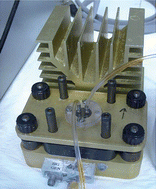In this report, the dielectric constant of glycerol solutions (0–70% (w/w)) and the mechanical transitions of poly(2-hydroxylethyl methacrylate-co-methacrylic acid) films (600–800 nm, 1.5–10 mol% cross-linker) have been investigated by the magnetic acoustic resonance sensor (MARS), which is an electrode-free acoustic sensor and operates over a continuous frequency spectrum (6–200 MHz). When a glycerol solution was loaded, the response of the MARS decayed exponentially as the operating frequency was increased. The decay rate against frequency as a function of the glycerol concentration reflects the change of the dielectric property of the glycerol solutions. In addition, mechanical relaxation of the poly(2-hydroxylethyl methacrylate-co-methacrylic acid) film has been observed on the MARS and the corresponding viscoelastic transition frequency has been estimated. The viscoelastic transition frequency increased as the polymer was more highly cross-linked. The MARS system behaved as a dielectric and mechanical spectrometer, monitoring the electrical and mechanical properties of viscoelastic materials or on the solid–liquid interfaces simultaneously, which has prospective application in studies of biomaterials, molecular interactions and drug deliveries.

You have access to this article
 Please wait while we load your content...
Something went wrong. Try again?
Please wait while we load your content...
Something went wrong. Try again?


 Please wait while we load your content...
Please wait while we load your content...